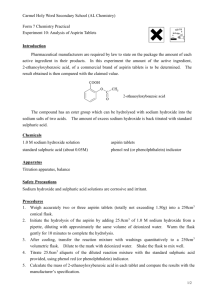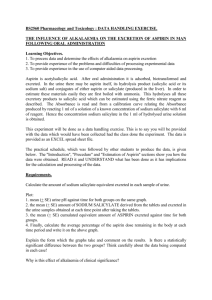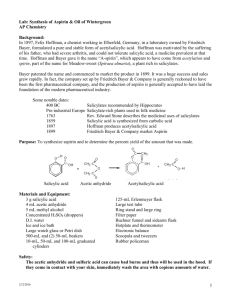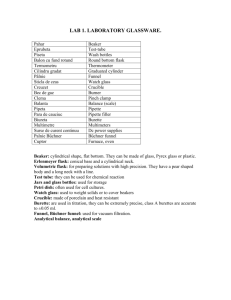Analysis of Aspirin - Eastern Michigan University
advertisement
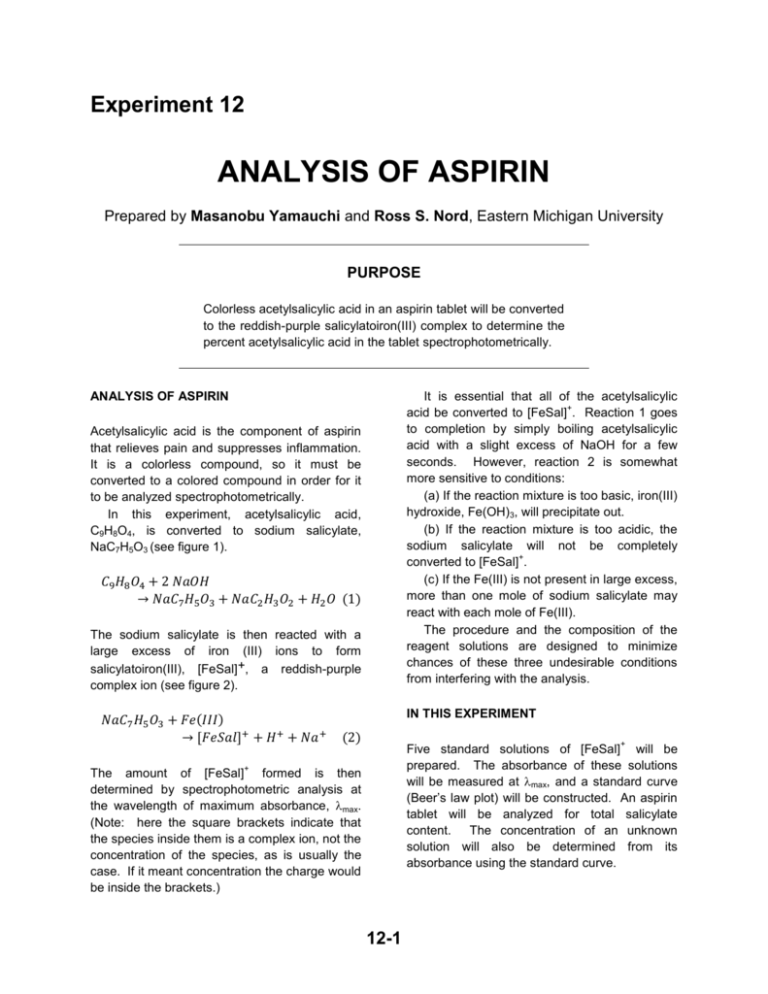
Experiment 12 ANALYSIS OF ASPIRIN Prepared by Masanobu Yamauchi and Ross S. Nord, Eastern Michigan University PURPOSE Colorless acetylsalicylic acid in an aspirin tablet will be converted to the reddish-purple salicylatoiron(III) complex to determine the percent acetylsalicylic acid in the tablet spectrophotometrically. ANALYSIS OF ASPIRIN It is essential that all of the acetylsalicylic + acid be converted to [FeSal] . Reaction 1 goes to completion by simply boiling acetylsalicylic acid with a slight excess of NaOH for a few seconds. However, reaction 2 is somewhat more sensitive to conditions: (a) If the reaction mixture is too basic, iron(III) hydroxide, Fe(OH)3, will precipitate out. (b) If the reaction mixture is too acidic, the sodium salicylate will not be completely + converted to [FeSal] . (c) If the Fe(III) is not present in large excess, more than one mole of sodium salicylate may react with each mole of Fe(III). The procedure and the composition of the reagent solutions are designed to minimize chances of these three undesirable conditions from interfering with the analysis. Acetylsalicylic acid is the component of aspirin that relieves pain and suppresses inflammation. It is a colorless compound, so it must be converted to a colored compound in order for it to be analyzed spectrophotometrically. In this experiment, acetylsalicylic acid, C9H8O4, is converted to sodium salicylate, NaC7H5O3 (see figure 1). 𝐶9 𝐻8 𝑂4 + 2 𝑁𝑎𝑂𝐻 → 𝑁𝑎𝐶7 𝐻5 𝑂3 + 𝑁𝑎𝐶2 𝐻3 𝑂2 + 𝐻2 𝑂 (1) The sodium salicylate is then reacted with a large excess of iron (III) ions to form salicylatoiron(III), [FeSal]+, a reddish-purple complex ion (see figure 2). 𝑁𝑎𝐶7 𝐻5 𝑂3 + 𝐹𝑒(𝐼𝐼𝐼) → [𝐹𝑒𝑆𝑎𝑙]+ + 𝐻 + + 𝑁𝑎+ IN THIS EXPERIMENT (2) + Five standard solutions of [FeSal] will be prepared. The absorbance of these solutions will be measured at max, and a standard curve (Beer’s law plot) will be constructed. An aspirin tablet will be analyzed for total salicylate content. The concentration of an unknown solution will also be determined from its absorbance using the standard curve. + The amount of [FeSal] formed is then determined by spectrophotometric analysis at the wavelength of maximum absorbance, max. (Note: here the square brackets indicate that the species inside them is a complex ion, not the concentration of the species, as is usually the case. If it meant concentration the charge would be inside the brackets.) 12-1 Experiment 12 – Analysis of Aspirin O H H H H O H H H O O O H H H H + Na H H + H O O Acetylsalicylic acid O H H O Fe H O [FeSal] + Sodium salicylate Figure 1. Structures of the reaction species. PRE-LABORATORY PREPARATION 1. Read the procedure and data analysis sections of the experiment. 2. Complete the computer-generated PRELAB assignment. Refer to the procedure and data analysis sections of the experiment as needed. The prelab questions for this experiment replicate some of the questions in the data analysis section. 3. Construct a complete, organized data sheet. You will want to record the concentration of the stock sodium salicylate provided, the volumes used to prepare the five standard solutions, all absorbance readings, and the mass of your aspirin sample. 4. Bring your own favorite brand of aspirin tablet for analysis-do not bring ibuprofin (Advil, Nuprin, Motrin, ...) or acetaminophen (Tylenol, ...). Tablets will be available in lab if you forget or don’t have any. EXPERIMENTAL SECTION REAGENTS PROVIDED WASTE DISPOSAL 0.20 M Fe(III), dissolved in 0.050 M HCl-KCl. Sodium hydroxide, 1M. Sodium salicylate, 0.004M. This will be dispensed by an auto-fill buret. Unknown solution of sodium salicylate. All of the chemicals used in this experiment may be safely disposed of by washing down the sink. SPECIAL EQUIPMENT Spectrometers and cuvets should be available in the lab. You must work at a station with access to a computer. Hazardous Chemicals PROCEDURE Hot 1M sodium hydroxide can cause serious damage to eyes. If NaOH gets on your skin, wash it off with copious amounts of tap water. Unless told otherwise, you will work with a partner (or two, if necessary) to prepare the standard solutions, determine the standard curve, and analyze the aspirin sample. Each student must analyze his/her own unknown sodium salicylate solution. 12-2 Experiment 12 – Analysis of Aspirin PREPARATION OF 0.02 M Fe(III) 6. Prepare cuvets containing four other + standard solutions of [FeSal] by taking 4.00, 3.00, 2.00, and 1.00 mL, respectively, of the stock sodium salicylate solution and diluting each aliquot (to 50.00 mL) with the 0.02 M Fe(III) you prepared. Proceed in the same manner as described in steps 3-5, above. Record the exact volume used for each solution. 1. Measure 100 mL of 0.20 M Fe(III) solution and pour it into a clean 1 L plastic bottle. Add distilled water until the bottle is full. The 1 L plastic bottle should be designated cabinets in the front and back of each room. It is not necessary to be precise in these measurements. Cap the bottle and mix thoroughly. This solution will be used to prepare + the [FeSal] solutions described in the subsequent sections. If you run out of this solution, and have to prepare more, you will be substantially increasing the amount of error in your results. 7. Calculate the concentrations of the standard solutions you have prepared. (This is Data Analysis question 1.) Each concentration can be obtained by performing a dilution calculation using the volume and concentration of sodium salicylate used and the final volume of solution (50 mL). In your calculation, be sure to use the actual stock sodium salicylate concentration, as recorded on your data sheet. Record your results in the Data Analysis section. 2. Fill a cuvet with the solution you prepared in step 1. This will be the blank cuvet used to calibrate the spectrometer. + PREPARATION OF [FeSal] SOLUTIONS 3. Transfer 5.00 mL of the stock sodium salicylate solution from the auto-fill buret directly into a 50 mL volumetric flask. On your data sheet, be sure to record the exact concentration of the stock sodium salicylate solution written on the bottle label. Also, record the exact volume of sodium salicylate used (to the nearest 0.01 mL). PREPARATION OF THE BEER’S LAW PLOT 8. Connect the spectometer and start up LoggerPro. 9. Using the blank cuvet prepared in step 2, calibrate the spectrometer as follows: (a) Click on Experiment then Calibrate… and then Spectrometer: 1. (b) Allow the spectrometer to go through the 90 second warm up if it was just connected. (c) Insert the blank cuvet into the spectrometer. The clear sides of the cuvet should be facing left & right (in the direction of the ► on the spectrometer). (d) Click on Finish Calibration. The calibration will finish in a couple of seconds. Then click on OK. 4. Return to your bench and add 0.02 M Fe(III), made in step 1, until the meniscus rests on the flask’s calibration mark. Cap the flask and mix thoroughly. This converts the sodium salicylate into salicylatoiron(III), see reaction (2). To avoid adding too much Fe(III) solution, use a medicine dropper to bring the bottom of the meniscus to the 50 mL mark. Mix the flask well by inverting the capped flask several times. 5. Fill a clean cuvet with this solution. Rinse the cuvet before filling it. Empty the 50 mL volumetric flask and rinse it thoroughly before reusing it. 10. Place the cuvet containing solution 1 (5.00 mL) in the spectrometer and click on Collect to measure the spectrum. Wait a few seconds for it to stabilize and then click on Stop. 12-3 Experiment 12 – Analysis of Aspirin 11. Click on the Configure Spectrometer icon (which is the colorful one, third from the right in the row of icons). Click on Abs vs. concentration. This changes the data collection mode to generate a standard curve. most to least concentrated. You can sort the data in LoggerPro afterwards (Data – Sort Data Set), if necessary. (f) At some point during the data collection, you may need to autoscale the axes (by double clicking on the graph and selecting the Axis Options tab). 12. Choose the wavelength of maximum absorbance and record this wavelength on your data sheet. By default, the program chooses to work at the wavelength of maximum absorbance. It indicates this with a box on the graph, as well as a check mark on the list. If it chooses a wavelength more than 35 nm away from 535 nm, you should click on the list to select the wavelength close to 535 nm with the largest absorbance (and click off the erroneous wavelength). Get help if needed. 16. Inspect your data for bad points. Your data points should be linear with the absorbances increasing as the concentration increases. If not, re-measure any suspect readings or remake them. It is always good to get an instructor’s opinion if you are not sure. If you wish to delete a data point, click on the row number in the data table and then select Edit from the top menu, followed by Strike Through Data Cells. (A data point can be restored by following the same procedure, but clicking on Restore Data Cells, instead.) 13. Click on OK. It will ask if you want to save the latest run. Click on No. 17. Click on the Stop button after five good points have been collected. If you have clicked on Stop, you can still collect additional data, by clicking on Collect and then choosing “Append to Latest”. 14. Click on the Collect button in the upper right of the screen. 15. Measure the absorbance of each of the five standard solutions. (a) Insert a sample cuvet (start with the most concentrated) into the spectrometer. (b) Wait for the absorbance reading to stabilize and click on Keep. Absorbance readings should typically be between 0 and 1. If your absorbance is outside of this range, you may have a problem. Get help, if necessary. (Furthermore, the absorbances should decrease as the concentration decreases.) (c) Enter the concentration of the solution (calculated in procedure step 7) into the box. (d) Record the absorbance, to the nearest 0.001, on your Data Sheet (next to the concentration of the sample). Since the absorbance is obtained by taking a logarithm (which is unitless), A is unitless. (e) Repeat steps (a)-(d) for the remaining standard solutions. Do them in order from 18. Perform linear regression on your data by clicking on the Linear Regression Icon. 19. Print out your Beer’s law plot. Be sure it has a title and everything is labeled properly. This will be turned in with your report. Do NOT shut done Logger Pro yet. You will be using it with your aspirin sample, below. ANALYSIS OF ASPIRIN SAMPLE This part can be done individually or in groups to save time. Assume you will work with your same group unless your instructor specifies otherwise. 20. Weigh out about 0.1 g of an aspirin tablet. Place a tablet on a watch glass or piece of weighing paper and use your metal spatula (or any other sharp object to which you have 12-4 Experiment 12 – Analysis of Aspirin access) to cut off a piece of your aspirin tablet which weighs about 0.1 0.02 g. Most aspirin tablets weigh about 0.4 g, so you need about ¼ of a tablet. Record the mass of the sample on your data sheet (to the nearest 0.001 g). We will call this solution B. 25. Measure the absorbance of solution B. Insert a cuvet containing this solution into the spectrometer and record (on your data sheet) the absorbance reading found at the bottom of the screen. It is not necessary to use the Collect or Keep buttons since this data is not part of your Beer’s law plot. 21. Transfer your sample to a 125 mL Erlenmeyer flask, and add about 5 mL of 1 M NaOH. Heat the mixture over a Bunsen burner flame until it begins to boil. This converts the acetylsalicylic acid into sodium salicylate, see reaction (1). A simple way to do this is to hold the flask over the flame with a pair of crucible tongs, gently swirling the contents. As soon as the mixture starts to boil, remove the flask from the flame and rinse the inside walls of the flask with a small volume of distilled water. Repeat the boiling-rinsing process. Most brands of aspirin create a white precipitate at this point. If you have a precipitate, repeat the boiling-rinsing process. If there is still a precipitate after three boiling-rinsing cycles go on with the experiment. ANALYSIS OF UNKNOWN This part can be done individually or in groups (if your instructor allows it) to save time. Assume you will work individually unless your instructor specifies otherwise. 26. Obtain your unknown solution. Each student should obtain an unknown. Bring the instructor or laboratory assistant a clean, dry 50 or 100 mL beaker. You will receive about 25 mL of unknown solution. Record the unknown number on your data sheet. 22. Allow the flask to cool, and transfer the contents into a 50-mL volumetric flask. Rinse the Erlenmeyer flask with distilled water, and pour the rinse solution into the volumetric flask. Repeat the rinsing process a couple of times so that all of the original mixture is transferred to the flask. 27. Use a rinsed pipet to transfer 10.00 mL of unknown into a clean volumetric flask. Fill to the 50 mL mark by adding the 0.02 M Fe(III) solution you prepared. The 10 mL pipet should be rinsed with a portion of the solution to be transferred (discarding the rinse solution) before using it to transfer the 10 mL to the flask. 23. Fill the volumetric flask with distilled water until the meniscus rests on the 50 mL mark and mix thoroughly. We will call this solution A. 28. Measure the absorbance of the solution. Record the absorbance on your data sheet. Use a brush and tap water to clean your glassware. Then rinse it with distilled water, dry it, and return it to your drawer. 24. Use a 1-mL volumetric pipet (available on the front bench) to transfer 1.00 mL of solution A from the volumetric flask into a clean 50 mL volumetric flask. Fill the new flask to the mark by adding the 0.02 M Fe(III) solution you prepared. This converts the sodium salicylate into salicylatoiron(III), see reaction (2). Return the 1-mL pipet and spectrometer to the front bench. Close Logger Pro. Wash your hands thoroughly before leaving lab. 12-5 Experiment 12 – Analysis of Aspirin Name Station Used Instructor/Day/Time _ Partner Partner Station Checked & Approved DATA SHEET You must construct a complete, organized data sheet to be used for recording all data during the experiment. It is most efficient to set up a table for your absorbance data (see your previous experiment for an example). Be sure to record all data with the proper number of significant figures and the correct units. 12-6 Experiment 12 – Analysis of Aspirin DATA ANALYSIS All calculations should be clearly organized, make proper use of significant figures and include the units. + 1. Calculate the concentration of [FeSal] in each standard solution. Show a sample calculation for standard solution 1 below: standard solution #1_____________________ standard solution #2_____________________ standard solution #3_____________________ standard solution #4_____________________ standard solution #5_____________________ 2. Copy the linear regression results for your Beer’s law plot below. You should enter the proper units (if any) for each. Turn in your Beer’s law plot with your report. slope _________________________ y-intercept _________________________ 3. Perform the following steps to calculate the percent acetylsalicylic acid in the aspirin sample: + a. Use the standard curve's slope and intercept to calculate the [FeSal] in solution B. Concentration of [FeSal]+ ______________________ + b. How many moles of [FeSal] were in the 50.0 mL of solution B? + Moles of [FeSal] ______________________ 12-7 Experiment 12 – Analysis of Aspirin c. How many moles of sodium salicylate were in the 1.00 mL aliquot of solution A used to prepare solution B? [Hint: look at the stoichiometry of reaction (2).] Moles of Sodium Salicylate_____________________ d. How many moles of sodium salicylate were in the 50.0 mL of solution A? Moles of Sodium Salicylate_____________________ e. How many moles of acetylsalicylic acid were in the aspirin sample? [Hint: look at the stoichiometry of reaction (1).] Moles of Acetylsalicylic Acid_____________________ f. Use the mass of the aspirin sample and the answer to part (e) to calculate the mass percent acetylsalicylic acid, C9H8O4, in the aspirin sample. Percent Acetylsalicylic Acid____________________ 12-8 Experiment 12 – Analysis of Aspirin EACH PERSON SHOULD ATTACH A SEPARATE PAGE WITH THE CALCULATIONS AND RESULTS FOR HIS/HER OWN UNKNOWN. 4. Calculate the molar concentration of sodium salicylate in the unknown as follows: a. Use the standard curve's slope and intercept to calculate the [FeSal] + in the 50.0 mL solution prepared from 10.0 mL of your unknown. Concentration of [FeSal]+_____________________ b. Calculate the concentration of sodium salicylate in the original unknown sample that you received. + [Hint, they are two ways to do this: (1) determine the moles of [FeSal] in the 50.0 mL solution; use this to get the moles of sodium salicylate in the 10.0 mL aliquot of unknown; and then use the moles and volume to get the concentration OR (2) do it as a dilution problem.] Concentration of Unknown Sodium Salicylate _______________________ Unknown Number _____________________ Name ______________________________________________________ 12-9
